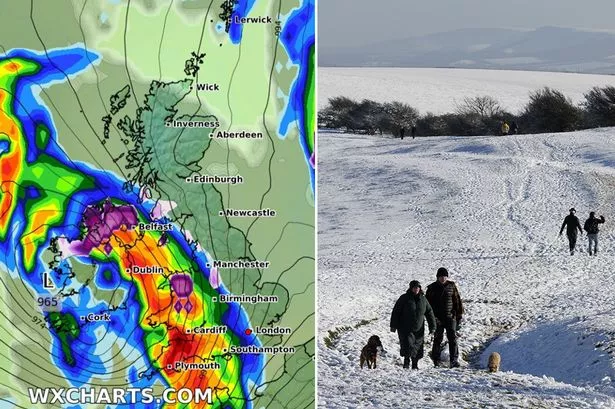The United Kingdom is bracing for a dramatic shift in weather patterns as forecasts predict a potent storm system poised to deliver a double whammy of heavy snowfall and torrential rain later this month. Advanced weather models paint a stark picture of a significant meteorological event capable of blanketing parts of the country in up to 10 centimeters of snow per hour, while other regions will grapple with intense downpours and potential flooding. This abrupt transition from relatively mild conditions to wintry extremes highlights the volatile nature of the UK’s climate and underscores the potential for disruptive impacts across various sectors, including transportation, infrastructure, and daily life. The impending storm presents a complex challenge, demanding proactive measures to mitigate potential hazards and ensure public safety.
The storm’s development is attributed to a confluence of atmospheric factors, including a powerful jet stream plunging southwards, drawing in frigid Arctic air, and interacting with moist, relatively warmer air masses over the Atlantic. This clash of air masses creates the perfect conditions for intense precipitation, with the form it takes – snow or rain – depending on the precise location and altitude. Areas at higher elevations and further north are most likely to experience heavy snowfall, while lower-lying and southern regions are more susceptible to torrential rain. The expected snowfall rates of up to 10 centimeters per hour are particularly concerning, as such rapid accumulation can quickly overwhelm snow removal efforts and lead to widespread travel disruptions, power outages, and isolated communities. The combination of heavy snow and strong winds further exacerbates the risk, potentially creating blizzard-like conditions in some areas.
The expected heavy rainfall also poses significant challenges. Prolonged and intense downpours can saturate the ground, leading to surface runoff and increased river levels. This elevates the risk of flooding in vulnerable areas, potentially impacting homes, businesses, and critical infrastructure. The sudden influx of water can overwhelm drainage systems, causing localized flooding even in areas not typically prone to such events. Furthermore, the combination of heavy rain and strong winds can increase the risk of landslides and mudslides, particularly in hilly or mountainous regions. The potential for widespread flooding necessitates proactive planning and preparedness measures, including flood warnings, evacuation plans, and the deployment of flood defenses.
The anticipated impact of this storm extends beyond immediate weather-related hazards. The rapid accumulation of snow can disrupt transportation networks, leading to road closures, flight cancellations, and delays in rail services. This can have significant economic consequences, impacting businesses, supply chains, and essential services. The heavy snow can also place strain on infrastructure, including power grids and communication networks, potentially leading to outages and disruptions in essential services. Furthermore, the extreme weather can pose risks to vulnerable populations, such as the elderly, homeless individuals, and those with pre-existing health conditions. Ensuring their safety and well-being requires targeted interventions and support systems.
In preparation for the impending storm, authorities are urging residents to take necessary precautions. This includes stocking up on essential supplies, such as food, water, and medications; ensuring adequate heating and insulation in homes; and having a plan in place in case of power outages. Motorists are advised to avoid unnecessary travel during the storm and to be prepared for hazardous road conditions. Checking weather forecasts regularly and staying informed about potential risks is crucial for everyone. Community support networks can play a vital role in assisting vulnerable individuals and ensuring their safety during the storm.
The forecasted storm serves as a reminder of the increasing frequency and intensity of extreme weather events, potentially linked to climate change. Investing in resilient infrastructure, strengthening emergency preparedness measures, and promoting sustainable practices are crucial steps in mitigating the impacts of future extreme weather events. International cooperation and collaborative efforts are essential to address the global challenge of climate change and build a more resilient future. The upcoming storm presents a significant challenge, but it also provides an opportunity to learn and adapt, strengthening our ability to cope with the changing climate and its associated risks. Proactive planning, community engagement, and a commitment to sustainability are essential for navigating the challenges and building a more resilient future.














